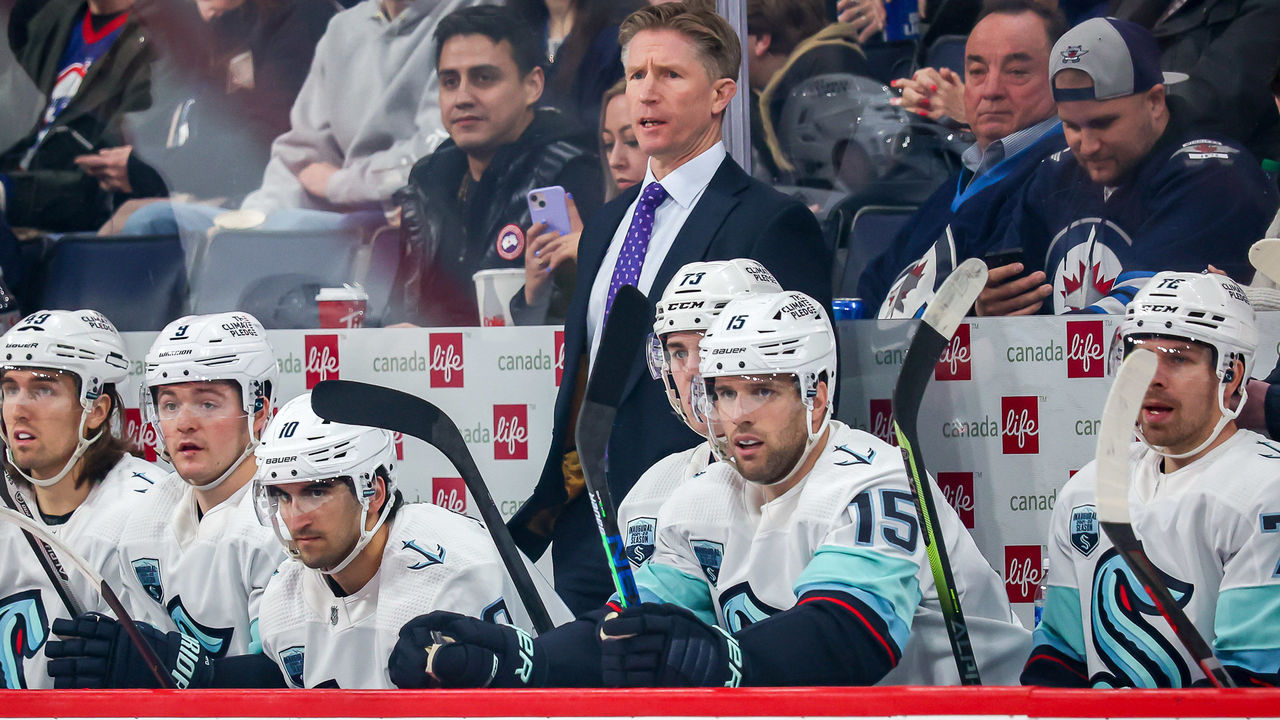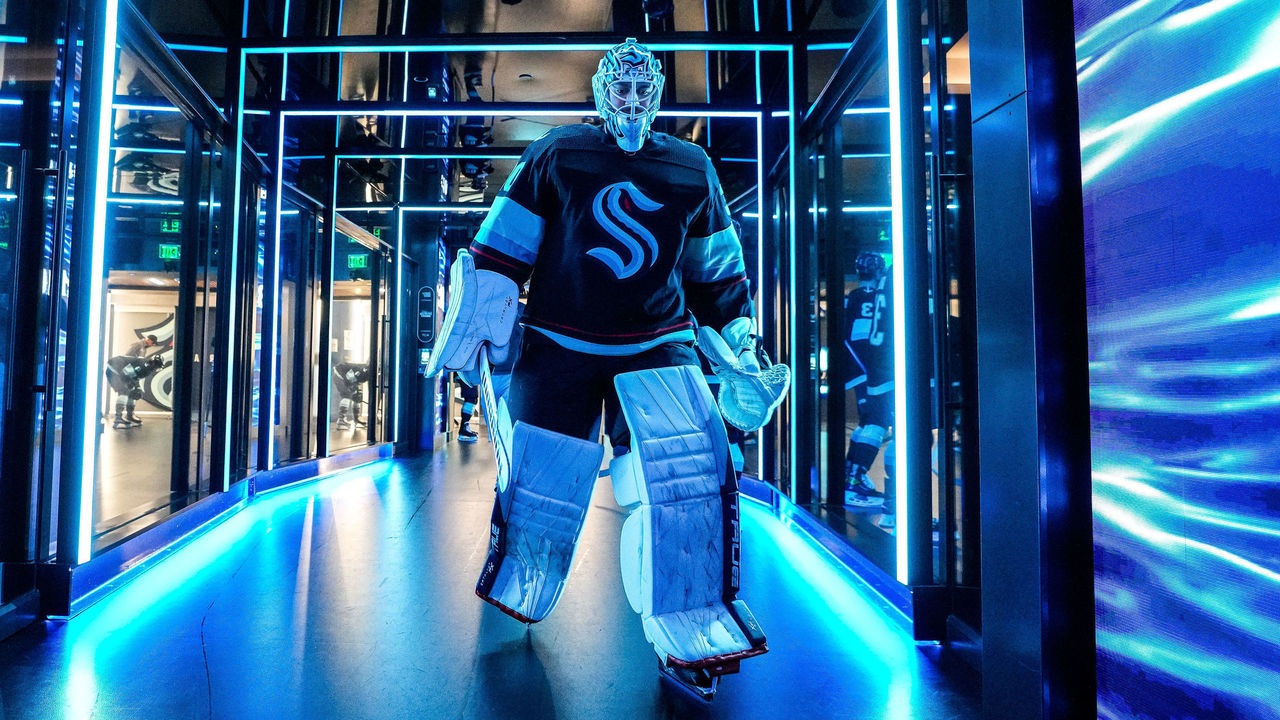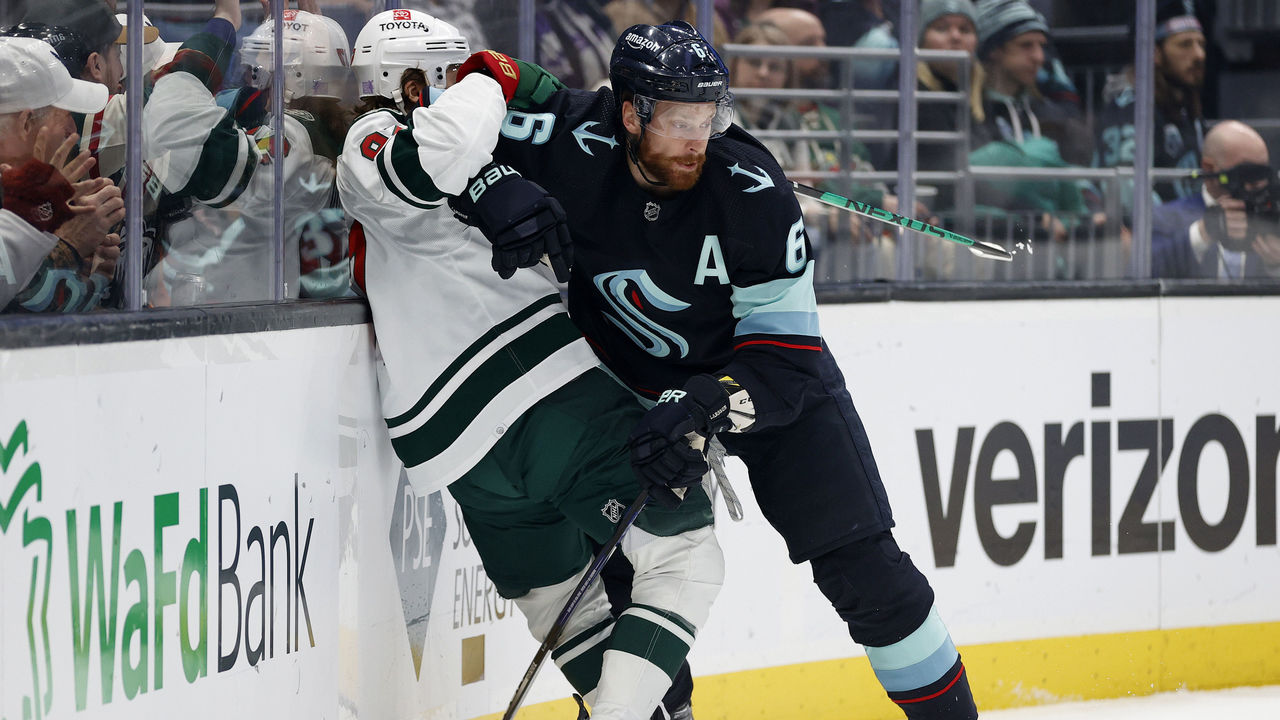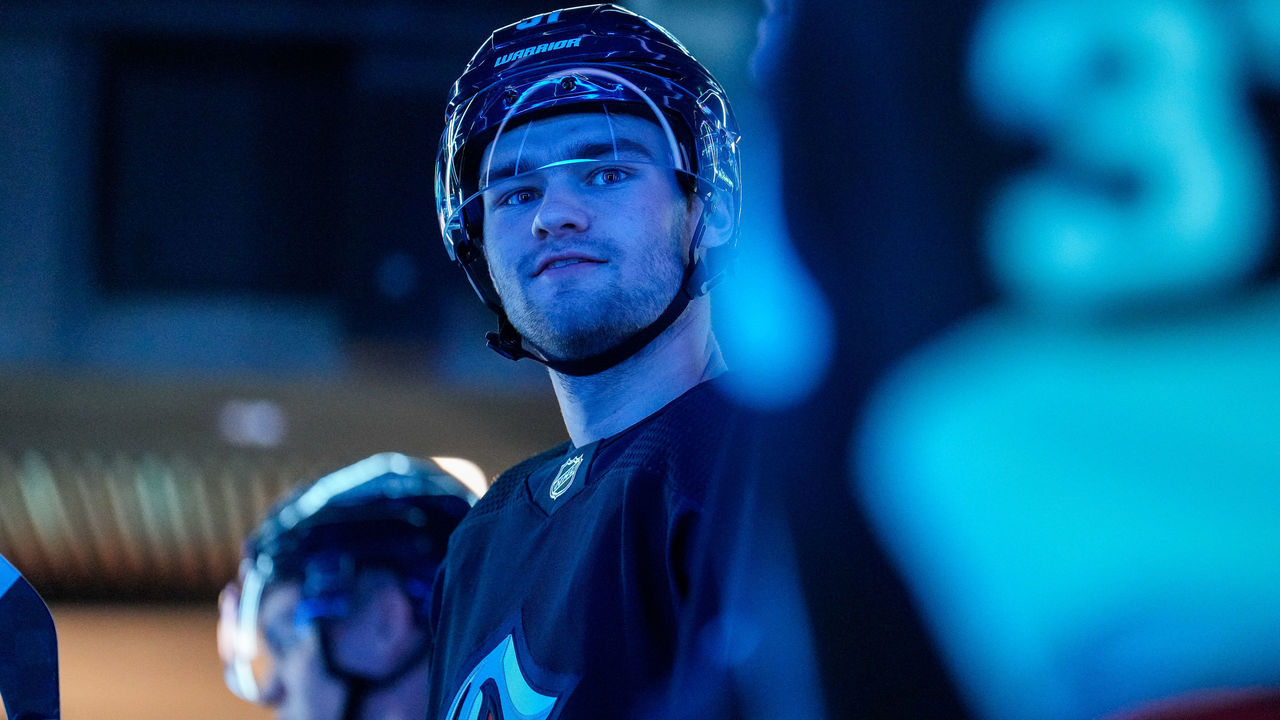Pushover no more: Why and how the Kraken are markedly better in Year 2
It's impossible to make definitive statements about teams and players a month into the NHL season. The sample size is simply too small for a sport as chaotic as hockey and for a league as obsessed with parity as the NHL.
That said, half-baked conclusions are welcomed anytime. And here's one the rest of the league would likely agree on: The Seattle Kraken, who lost 39 games by two goals or more in their debut campaign, are far from a pushover in Year 2.

At 8-5-3, the Kraken have won half of their games. They've kept most of the remaining contests close, losing by a single goal six times. At worst, they've established themselves as a scrappy underdog. At best, they've laid the foundation to challenge for a playoff spot in a wide-open Western Conference.
"Coming into the year, we wanted to make sure we moved in the right direction," Kraken head coach Dave Hakstol said in an interview late last week. "Early on, we've been able to show that, demonstrate it night to night."
So what's happened? In which specific areas has Seattle leveled up?
With insight from Hakstol, data from analytics firm Sportlogiq, and some game footage, let's examine why and how the Kraken are markedly better.
Dependable goaltending
Any sincere discussion about the Kraken must begin with goalie performance.
In 2021-22, the trio of Philipp Grubauer, Chris Driedger, and Joey Daccord torpedoed all hope of relevancy by posting a cumulative save percentage of .880 and a goals saved above expected of minus-37.5. Only the New Jersey Devils, who trotted out seven goalies, had comparable results in the crease.
This season, with Driedger unavailable as he recovers from knee surgery and Grubauer out after suffering a lower-body injury in the team's sixth game, offseason signee Martin Jones has carried the load with a .909 save percentage. Through 16 games, the Kraken's team SV% (.897) and team goals saved above expected (minus-0.47) rank 19th and 10th, respectively, in the NHL.

"Martin's been a huge part of some of the modest success we've had early on," Hakstol said. "We all know good goaltending allows you to feel good about what you're doing. It can erase mistakes, which usually leads to success. With a guy who's giving you those solid performances - plus one or two extra saves - that just builds the group. It builds confidence, swagger."
Jones, 32, is best known for helping the San Jose Sharks reach the Stanley Cup Final in 2016. He wasn't inked to a one-year, $2-million deal to be the Kraken's new No. 1; general manager Ron Francis had already committed to Grubauer ($5.9-million cap hit through 2026-27) and Driedger ($3.5 million through '23-24). Jones was essentially a short-term bet - a 400-game veteran who, as Francis put it in July, "adds competition to our goaltending group."
"He's done everything you would hope for," Hakstol said.
Martin Jones with a huge save on Kirill Kaprizov to keep the Kraken within 1.
— Emerald City Hockey (@EmeraldCityHky) November 12, 2022
Cliché time: remember this one if the Kraken come back and tie it. pic.twitter.com/zmUaiHOa4Y
Neutral-zone magic
Aside from replacing first-year captain Mark Giordano with the promising Will Borgen, Francis and Hakstol more or less left the blue line untouched.
Staying the course isn't sexy - especially after a mediocre debut - but in this case it makes sense, as Adam Larsson, Vince Dunn, Jamie Oleksiak, Justin Schultz, Carson Soucy, and Borgen set an appropriate tone in the defensive end.
Seattle's team defense, as measured by five-on-five expected goals against, has been steady compared to last season (2.40 per 60 minutes last season and 2.42 currently). In both seasons, the Kraken have defended well off the rush, cycle, and forecheck, while this year's team is allowing the 10th-fewest scoring chances off rebounds at 1.6 per game, or the exact same rate as last year.
Defensive-zone structure has never been an issue and there are no glaring areas of concern when it comes to playing without the puck.

"The piece that we needed to improve was getting out of our own zone - the exit," Hakstol said. "It's the second play, too, not just the first pass. It's being able to make the next play that gives you a chance to get through the neutral zone without a turnover. And then that leads you to the offensive zone."
Hakstol's analysis aligns with the data.
In both years, the Kraken have been a top-10 team in controlled zone exits (eighth in 2021-22 with 75.4 per game, fourth this season with 74.4). The real improvement can be found in that "second play" Hakstol mentioned. The 2021-22 squad was by no means horrible at transporting the puck through the neutral zone at five-on-five (7.9% neutral-zone turnover rate, fourth in the NHL). However, the current group paces the entire league with a neutral-zone turnover rate of just 6.6%.
The sequence below, which shows Oleksiak scoring in a 4-0 win over the Minnesota Wild on Nov. 3, is an example of how a clean zone exit, coupled with smart neutral-zone puck management, can lead to a quality chance.
Jamie Oleksiak scores against the Minnesota Wild to make it 2-0 #MINvsSEA #mnwild #SeaKraken pic.twitter.com/6SvJs82kD7
— nopClips (@nopClips) November 4, 2022
Focus on quality looks
Speaking of quality chances, it takes only a glance at Seattle's five-on-five heat maps at HockeyViz to recognize a significant change in the attack.
The 2021-22 heat map on the left features a red blob on the left point and blue splashed across the slot and net-front areas, whereas this season's map shows a high volume of shots originating from three different areas - the right point, right flank, and upper slot - as well as plenty of action on the left flank and in the net-front area. It's boosted Seattle's expected goals for per 60 minutes by almost half a goal.

Hakstol, the Philadelphia Flyers' head coach from 2015-18 and an assistant for the Toronto Maple Leafs from 2019-21, delivered an overarching message to Kraken players during training camp: Get to the "critical areas."
"Everybody looks at the heat map as the final product," said Hakstol, a 54-year-old former minor-pro defenseman now working for one of the NHL's most data-friendly clubs. "In reality, to be able to get inside you've got to possess the puck and you've got to create a little bit of space in the offensive zone. Honestly, that's been the biggest area of improvement for our group."
This year's team has spent only two extra seconds per game possessing the puck in the offensive zone, yet, as the heat maps suggest, the Kraken's typical offensive opportunity has shifted away from a low-percentage chance of scoring (point shot) to a high-percentage chance (upper-slot shot). As Hakstol suggested, they're not wasting possession time by setting up a perimeter shot.
Sportlogiq gives each offensive opportunity an A, B, or C grade and then produces a metric called "quality chances" by combining the A and B opportunities. This helps filter out easy saves and offers a better reflection of a team's in-zone efficacy. Year over year, the Kraken have jacked up their quality-chance rate from 10.0 per game (26th in the NHL) to 13.9 (20th).
"The makeup of our forward group is different than it was last year, so this was an area we felt we could be much more effective in," Hakstol said.
Injection of dynamism

To continue Hakstol's thought for him, he has access to more high-end skill.
For starters, veterans Jaden Schwartz and Brandon Tanev both missed time last year; they've contributed 10 points apiece this season. The dynamic Andre Burakovsky (team-leading 14 points) and underrated Oliver Bjorkstrand (nine points) look like shrewd offseason acquisitions. Speedy Matty Beniers, who impressed in 10 games last season, is a full-time NHLer.
With expansion-draft headliners Jordan Eberle, Yanni Gourde, and Jared McCann providing additional pop, the Kraken's forward group is suddenly dangerous. The early returns: 3.25 goals per game versus 2.60 in 2021-22.
Seattle lacks a true superstar at any position, although Beniers - a wizard with the puck who's a nightmare to defend in transition and also responsible defensively - is trending toward something resembling superstardom.
The No. 2 pick in the 2021 draft, Beniers is tied for second in rookie points with nine while skating for 17:27 a night. He's tops among first-year players in multiple five-on-five metrics, including loose-puck recoveries, open-ice dekes, and blocked passes. Not only is he dynamic, he's extremely smart - already king of the small details, which is captured nicely in this video compilation:
Hakstol was asked what's impressed him the most about Beniers' start.
"I can list a lot of things in terms of skill packages and things of that nature, but for me it's his drive to succeed and to improve his game that impresses me most," the coach said. "It's also his maturity in handling all of the different situations, whether it's small successes or small failures. You name it, he handles it very well. He's always ready for the next test, the next challenge."
The Kraken's other rookie, Shane Wright, has only dressed for seven games, recording one assist and one shot in 57 total minutes. While he could be returned to the OHL at some point (possibly soon), the 2022 fourth overall pick is currently caught in limbo: He's ostensibly outgrown junior, yet he doesn't appear ready for regular duty within Seattle's improved forward group.
"This is not an easy league to play in as an 18-year-old center," Hakstol said.

The bench boss is quick to compliment Wright's hockey sense, work ethic, and attitude. As for areas of growth, Hakstol threw out a few examples.
"The things we're working on with him on a daily basis are his play with the puck, his confidence with the puck, and the options he's seeing on the ice," Hakstol said. "Part of that can be grown by the work he's doing away from game action. Part of that is going to have to come within game action."
This past Sunday, Wright was scratched for the third game in a row and ninth time overall. If he's scratched again Thursday against the New York Rangers and Saturday versus the Los Angeles Kings, he'll be eligible for a two-week loan to the AHL, which may be the best place for the youngster.
The silver lining to this conundrum for Seattle fans? There's been no need to force Wright into the lineup. Everything from the goaltending to the transition game to the offensive attack has leveled up in Year 2. It's early, and the Kraken haven't evolved into a Stanley Cup threat overnight, but the first month of the season indicates the NHL's 32nd franchise is headed in the right direction.
John Matisz is theScore's senior NHL writer. Follow John on Twitter (@MatiszJohn) or contact him via email ([email protected]).